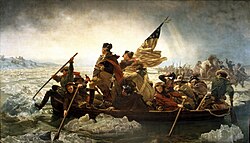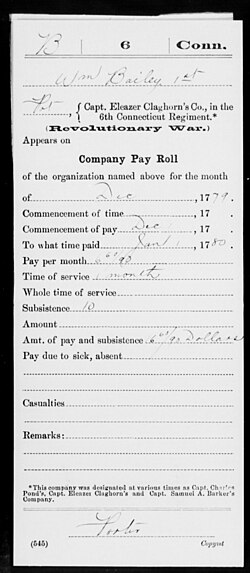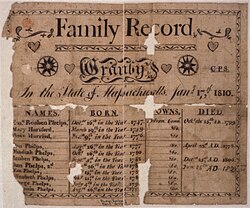
U.S. Revolutionary War records are documents relating to the American Revolutionary War, also known as the Revolutionary War or the American War of Independence, which occurred between the dates of April 19, 1775 to September 3, 1783. The purpose of this war was for the 13 colonies to gain their independence from England to create their own country. There were approximately 2.5 million people living in the 13 colonies in 1776[1] and many of them took sides during the war. Many individuals who sided with the patriots took up arms to fight the British while others found important ways to contribute where they could.
Many genealogists that have ancestors who fought in this war or helped with materials during the war could find records in the many archives and online databases available. Even if your ancestor didn’t actually fight during the war, they could have aided the cause of independence by offering their talents and resources in different ways that helped in winning the war. Records relating to the U.S. Revolutionary War include:
Compiled Military Service Records

U.S. Revolutionary War service records were created beginning in the 1890s by the United States War Department.[2] These records were compiled for most of the volunteer soldiers who participated in the war and were transcribed from original muster rolls, payrolls, regimental returns, descriptive books, hospital rolls, and other records. They were compiled for most of the soldiers of the war and can be found in the U.S. National Archives in Washington D.C. The information that can be found in the Revolutionary War service records includes:
- Soldier’s Name
- Soldier’s Rank
- Company the Soldier Served
- Payroll Information
- Muster Roll, Dates Present or Absent
Pension Records

Revolutionary War pension records and bounty-land warrant application files dated between 1800-1900 are available for those who served during the war and were injured or became ill due to their service. These records are also available for widows of soldiers who died during the war or since the war ended. These pension records can be a gold mine for genealogists searching for information about their ancestors during these early years of the United States. The first pension act, enacted on August 26, 1776, allowed pensions for soldiers and sailors who had been injured in the service of the colonies and were therefore incapable of earning a living. Not every Revolutionary War soldier received a pension but it is well worth looking into.
These records can be accessed in the U.S. National Archives, abstracts on MyHeritage.com, and other online resources. Information that can be contained in the Revolutionary War Pension Records includes:
- Soldier’s Name
- Soldier’s Rank
- Soldier’s Unit
- Dates of Service
- Soldier’s Age
- Soldier’s Date of Birth and sometimes Birthplace
- Soldier’s Residence
- A widow’s application could include her maiden name and the date and place of her husband’s death
- Additionally, the pension files could contain affidavits, service information, records of commissions, discharge information, receipts, diaries, letters, pages from the family Bible and vital records to prove birth, marriage and death dates.
Bounty Land Warrants
The U.S. Government awarded bounty-land warrants to soldiers as a reward for their service during the Revolutionary War. The bounty-land warrants gave rights to land in the public domain to those soldiers who met eligibility requirements related specifically to their service. From 1775 to 1855 the United States granted bounty-land warranted for military service but also rewarded veterans for service during the Revolutionary War. Early warrants could only be used in military districts. Later, the U.S. Congress expanded eligibility to include service in the Regular Army and the Navy, as well as volunteer militias. The U.S. Government stopped issuing bounty-land warrants after 1855. The bounty-land warrants can be ordered from the U.S. National Archives in Washington, D.C. Information that could be found in bounty-land warrants includes:
- Name of the soldier receiving the land
- The U.S. state the land is located
- Witness statements
- Signature of the bounty-land recipient
Non-Military Service
There were individuals who contributed to the U.S. Revolutionary War without being a soldier. These individuals offered what they had for the war effort. There were individuals who offered their homes for various uses during the war, such as hospitals, regimental offices, and other ways to support the troops. Others provided materials such as food, crops, uniforms, housing, weapons and even transportation. Information about non-military contributions be found in:
- Personal family papers such as diaries, letters and scrapbooks
- Government records in the U.S. National Archives kept during and after the war
Explore more about U.S. Revolutionary War records
- Revolutionary War Pension Records collection at MyHeritage
- Revolutionary War record collection at MyHeritage
- Military Records: Search by Name on MyHeritage on the MyHeritage Knowledge Base
- Ask The Expert – Military Records on MyHeritage - a webinar by David Allen Lambert on the MyHeritage Knowledge Base
- How I Proved That My Ancestor Was an American Revolutionaryon the MyHeritage blog
- African Americans in the U.S. Revolutionary War at Legacy Family Tree Webinars
- A Genealogical Gem in DC: The DAR Library at Legacy Family Tree Webinars
- Remote Research in the Databases of the Daughters of the American Revolution Genealogical Research System at Legacy Family Tree Webinars
- American Revolution Genealogy at Legacy Family Tree Webinars
- The Loyalists That Stayed Behind: The Reintegration at Legacy Family Tree Webinars
- U.S. Revolutionary War: A Case Study Approach at Legacy Family Tree Webinars
- A Revolutionary War Case Study: Joseph L. Harper at Legacy Family Tree Webinars
- Revolutionary War Series 1 of 5: The Revolution – More than just the War at Legacy Family Tree Webinars
- Revolutionary War Series 2 of 5: The Participants in the War at Legacy Family Tree Webinars
- Revolutionary War Series 3 of 5: Records Created by the Revolutionary War During the War at Legacy Family Tree Webinars
- Revolutionary War Series 4 of 5: Records Created by the Revolutionary War After the War – Pensions at Legacy Family Tree Webinars
- Revolutionary War Series 5 of 5: Records Created by the Revolutionary War After the War – Bounty Land at Legacy Family Tree Webinars
References
- ↑ The 13 Colonies. History Channel
- ↑ Basic Military Records at the National Archives. U.S. National Archives